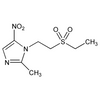Tinidazole is a broad-spectrum second-generation 5-nitroimidazole antibiotic and synthetic antiprotozoal agent introduced in 1969. This imidazole derivative is used against bacteria, protozoa and parasites. The compound is similar structurally to metronidazole and has similar spectrum. In vitro, it has similar protozoal activity to metronidazole. It is used as a reference standard for analytical applications such as method development and food safety.
Tinidazole is soluble in acetone and methylene chloride.
| Mechanism of Action | Tinidazole is an antibacterial and alkylating agent and is considered a prodrug. In Trichomonas, it introduces alkyl radicals in the form of free nitro radical which binds to parasite DNA in a covalent way, leading to DNA damage and cell death. The mechanism by which Tinidazole exhibits activity aganst Giardia and Entamoeba species and anaerobic bacteria is not known but it is expected to be similar to metronidazole. |
| Spectrum | Tinidazole is active against protozoa and anaerobic amoeba, and some Gram-negative anaerobic bacteria including Bacterioides spp. It can be used for Helicobacter pyplori, Trichomonas vaginalis (causal agent of trichomoniasis) and G. duodenalis, the causal agent of giardiasis). It can be used for E. histolytica (causal agent of intestinal amebiasis). It has a similar spectrum to metronidazole. |
| Microbiology Applications | Tinidazole has in vitro and in vivo activity against the following protozoa: Trichomonas vaginalis, Giardia duodenalis, and Entamoeba histolytica. It does not have activity agaisnt vaginal lactobacilli. An in vitro metabolic interaction study revealed that Tinidazole at up to 75 μg/ml did not inhibit the following enzymes: CYP1A2, CYP2B6, CYP2C9, CYP2D6, CYP2E1, CYP3A4. |
| Eukaryotic Cell Culture Applications | A characterization of the cytotoxic and genotoxic activities of Tinidazole was explored in cultured human lymphocytes at clinical concentrations (0.1, 1, 10, 50 ug/ml of culture). A significant decrease in mitotic index (MI) and an increase in sister chromatid exchange (SCE) was observed. No modification of replication index (RI) was found. The results indicate a genotoxic and cytotoxic effect modulated through apoptotic mechanisms (Lopez and Carballo, 2008). |
| Molecular Formula | C8H13N3O4S |
| References |
Fung HB, Thien-Ly Doan T (2005) Tinidazole: A nitroimidazole antiprotozoal agent. Clin. Ther. 27(12):1859-1884 Lopez Nigro MM and Carballo MA (2008) Genotoxicity and cell death induced by Tinidazole (TNZ). Toxicol. Lett. 180(1):46-52 Sawyer PR et al (1976) Tinidazole: A review of its antiprotozoal activity and therapeutic efficacy. Drugs 11, 423–440 |



